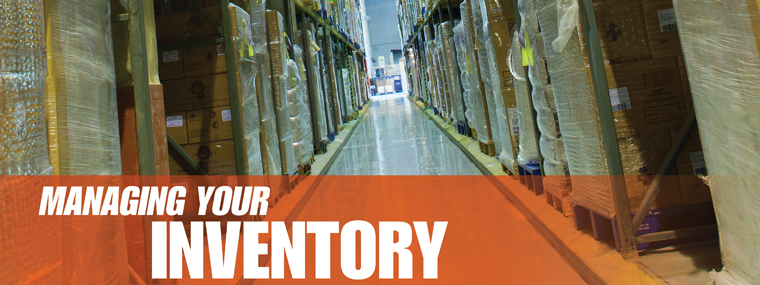
Managing Your Inventory
By Beth Borrego / Published December 2015

How many of us remember the story of Goldi-locks and the three bears? There were three beds, one that was too soft, one that was too hard, and one that was just right. A small business owner might feel like Goldilocks at times, trying desperately to strike a balance between not having enough product on hand, and having so much inventory that it depletes your working capital. In this article, we’re going to take a look at keeping your inventory at a reasonable level so that it doesn’t cripple your cash on hand. This applies to contractors, distributors, and manufacturers alike.
If you are a contractor, you’re probably used to buying job by job, in an effort to keep all of the money in the bank that you can except for the amount of required materials necessary for the job. And, of course, if you’re a distributor, you’re probably used to getting those calls for one or two items placed at the last minute for the above mentioned upcoming job. You’ve probably tried to talk to your customer about the savings they might have if they bought “x” amount to get the free shipping too. Further up the supply chain, if you are a manufacturer, you probably wish your vendors would buy parts based upon historic need.
Purchase history and repeat frequency is something that is creeping into our daily lives. Many of you reading this probably shop on Amazon. The next time you are online take a look at some of the consumable products they have there. You can set up an order to repeat ship every so many weeks or months. This typically applies to items that are constantly going to be used or go out of stock.
Our industry feels the pinch of being seasonal, and there are high and low points to annual purchases; in fact, you can almost mark your calendar for them. In the spring, about the time the weather is going to break, contractors begin to get calls for work. At this point, the seasoned contractors who know what’s right around the corner will place orders for their most commonly used products, so they don’t have to wait for stock to be available. The distributors who track their annual purchases know to have stock ready when the weather breaks, and, in many cases, some will contact their customers to see if they are ready for the first order of the new year. The manufacturers know that there will be an increased need for certain parts along with new equipment in the spring. For example, if someone fails to winterize a machine, that contractor needs the parts from his distributor, and in turn the manufacturer knows this and is most likely ready.
How much is too much and how little is too little? If you are brand new to the business, it’s perhaps a little more difficult to pin down what you will need. In fact, even those who have been at it for a while struggle at times. These helpful tips might be just what you need in order to manage your inventory better.
If you’re a contractor who frequently uses particular products on jobs, consider these ideas. They might just save you money.
Stick to a select few common colors that you use frequently if you are staining wood for example.
Order the chemicals you need in reasonable amounts if it nets you a discount.
Some vendors offer free shipping or discounts when you buy a certain volume, and that might be worth doing on commonly used items.
Take advantage of sales on common items and parts you go through like hoses, tips, etc.
Avoid waiting until you are running so low on product that you’ll run out and have a backorder situation while waiting for stock to arrive. For example if you know that you sell 80 widgets per month, with an average of 20 widgets per week, but it takes your widget supplier four weeks to supply you with inventory, then you know that if your inventory falls below 80 you will most likely run into a back order that month.
Let’s face it, when you run out of a popular item, it’s going to cost you money in several ways. First of all, those who need the product to ship today or tomorrow, will shop elsewhere because they don’t have four weeks to wait for their widgets. Those who do wait, are going to call and inquire, which will tie up your staff’s time when they could be taking orders for other products that are in stock. Your staff won’t have widgets to ship, but when they arrive there might be overtime associated with bringing them into inventory, picking the backorders, and shipping them quickly. While you may not want to order six months or a year’s worth of product at a seemingly unbelievable price, making sure you have a reasonable amount with a set reorder point is a good idea. Beware of ordering an odd item in a large quantity or you might be stuck with it for an undetermined period of time.
If you do have a stock overage, it might be tempting to sell it fast and cheap to recoup your capital, but you will lose money if it means selling it below what you initially paid for it. Maintaining a certain level of stock, and setting a reorder point is a better way to go about ensuring that you’re maximizing your available working capital.
The smaller mom and pop companies most likely do inventory by hand, but the bigger you become the more an automated inventory system is worth exploring. While your company is small, you can easily maintain an inventory weekly, semi-monthly, monthly, or as you need to. As your business grows, you’ll begin to feel the growing pains associated with manual inventory methods. At this point, you’ll need to explore inventory systems that will allow you to receive and deplete inventory, while providing you with an accurate count of what’s on hand. For much smaller mom and pop businesses, creating an Excel spreadsheet where you can electronically update inventory might work just fine and for small contractors this should be a good method of recording what’s on hand. Additionally, some of the most popular accounting software programs used for small businesses like QuickBooks and Sage’s Peachtree both offer an inventory feature. However, if you are a distributor or manufacturer with a pick, pack, and, ship facility that turns inventory daily, then you will no doubt need to explore more expensive and robust options, such as barcode software and hand held scanners that can be integrated with your current systems.
Companies that do pick, pack, and ship products typically have to worry about the accuracy of their inventory. When stock gets low, the question of if you truly do have something on hand or not comes down to what’s called variance. If you are off by one to two percent or more of your most common items, that means that someone is going to be unhappy, and that someone is your customer. Using a barcode system with a scanner can reduce that variance to nearly nothing, less than one percent.
There are other concerns that can impact your inventory as well. Stock that doesn’t move costs you not only the money you have invested in purchasing it, but now that you are stocking those items, they are taking up valuable space, using human resources to count and perhaps move the stock around as needed. You must also consider that there are also utilities involved in keeping the lights and heating or air conditioning on in the facility where the stock is located, insurance to cover that stock, and if the item has a shelf life, the clock is ticking there too. If your stock becomes damaged, you now have to contend with the decision to replace or sell the stock at a discounted rate. These are just a few of the examples of the impact that inventory can have on your cash flow.
Make sure your inventory is organized. This might seem like a no brainer, but properly organizing your inventory can increase your efficiency and the accuracy of your inventory. Don’t stack items too high, as this can make them time consuming to retrieve. Make sure you have like products organized together by category. For example, if you sell add-on equipment for pressure washers, stock all of your electric hose reels in one area, and label them by brand to distinguish one kind from another, then place all the hand crank hose reels together, labeled accordingly. Consider not placing the electric and the hand crank next to one another, since the item might be miss picked. Items that turn over the fastest should be placed closer to the front of the warehouse so that they are more efficiently picked, packed, and shipped. Put heavier items on the bottom; keep the lighter ones higher up. You don’t want to be on a step ladder retrieving a heavy item, because it only increases the likelihood of a workplace injury. Less fatigue is always better for your staff. By evaluating how you handle your physical inventory items and working to streamline your process and purchase effectively, you’re maximizing your cash flow and that’s good for your bottom line.





